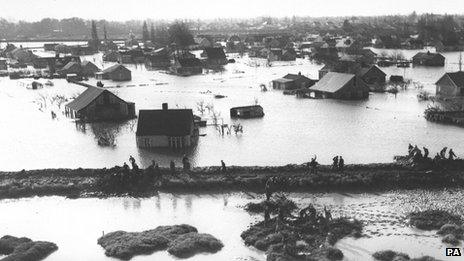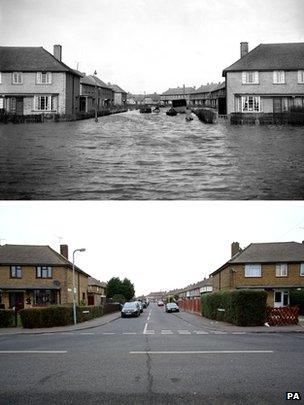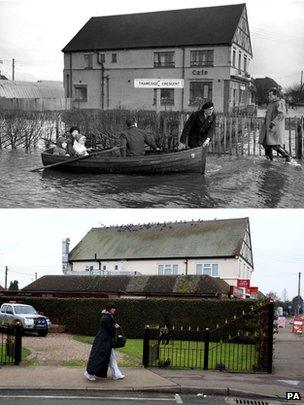Memories of 1953 flood live on in Canvey Island
- Published

Fifty-nine people were killed on Canvey Island in the 1953 floods
When floods devastated large parts of the East Coast in 1953, Canvey Island in Essex was one of the places that bore the brunt.
Fifty-nine people died and 13,000 were evacuated from their homes after floodwater inundated the island on 31 January.
Parts of the reclaimed island in the Thames estuary lie below sea level, meaning the town must be ever-vigilant against the threat from the sea.
Sixty years on, a large sea wall protects the island but memories of the floods live on.
From street names including Dyke Crescent and Deepwater Road to the King Canute Pub, reminders of Canvey's historical relationship with the sea can be found around every corner.
One of the most memorable photographs of the floods shows the junction of North Avenue and Thameside Crescent deluged, with houses acting as a riverbank.

North Avenue in Canvey Island, pictured on 2 February 1953, and below, how it looks today
Frantic search
Joyce Spencer, 82, lived on North Avenue and now lives on Thameside Crescent.
"I remember January 31 very clearly," she said.
"We had been visiting family off the island and as we returned we noticed how high the water was along the embankment.
"We decided we couldn't go home so chose to stay off the island.
"There was a blackboard where anyone who got off was supposed to write their name so that everybody knew they were safe.
"There were children in our family whose names weren't on the board so we were frantically searching for them.
"Luckily we soon found out they had been evacuated by the Army. There were others who weren't so lucky."
'Perished on rooftops'
Geoff Barsby, then seven, also lived in North Avenue.
"As a child you see it as an adventure," he said.
"You don't feel fear because you don't think of the people on rooftops dying of exposure.
"One memory I have is looking out of the window and imagining being able to fish off my own doorstep.
"The next day it became clear just how terrible it was. In those days Canvey was a small community and everybody knew somebody who died.
"I remember our rabbit and our chickens were killed but we were lucky as, unlike most, we lived in a house with a second floor.
"The real tragedy was the people who perished on rooftops. It wasn't the water that got them, it was the terrible cold."
Pram washed away

Residents of Thameside Crescent, pictured then and now, were evacuated after the floods struck
Despite the tragedy, there were moments of hope and even humour.
One popular story in the town is that of baby Linda whose pram was washed away by the tide.
Her parents were both killed but she was later found, safe and well, floating in her pram and was raised by grandparents.
Dave Blackwell, who was six when the floods came, remembered a story his uncle told him.
"He and a friend were paddling a canoe up New Street," he said.
"They saw a larger lady who called for help. Before they knew it she had jumped on board, gone right through the bottom and sunk them. They all needed rescuing after that."
But he, as much as anybody, is aware of the human cost.
'Mud and mess'
Mr Blackwell, son of the late firefighter Henry Blackwell, said: "We had a bell in the house which would ring every time there was a fire.
"I remember being woken by a commotion. The next morning we looked out of the window and thought it had snowed but it was the sun shining on the floodwater.
"My father and his colleagues had to find whatever boats they could to rescue people. There were a lot of people they couldn't get to and couldn't save.
"We were evacuated to London for six weeks while he stayed behind. When we returned I just remember all the mud and mess.
"It wasn't until he was in his 80s that he was able to tell us some of what happened but even then there were things he had seen that he didn't want us to know about.
"I think the worst thing for him was retrieving bodies from houses. They were the bodies of people he knew, that was the hard part."
'Proper warning systems'
Today the question that matters most to islanders is "could it happen again?".
Despite the threat of rising seas, most feel safe as a result of a £6m scheme to protect the area.
Mr Barsby said: "Before the floods the town was protected by a grass mound which hadn't changed much since it was built by the Dutch in 1622.
"If we still had those same defences, Canvey would be flooding all the time. But we now have a modern wall and proper warning systems.

County councillor Ray Howard said the floods had inspired him to enter local politics
"You can never say you're completely safe, but it would take something pretty massive to breach those defences."
Essex Conservative county councillor Ray Howard, another former North Avenue resident who was 10 when the floods hit, has spent 40 years in local politics and served on various flood defence committees.
He said his life in politics was inspired by the tragedy.
"The terrible thing was going back to school and seeing which of your classmates hadn't made it," he said.
"That will always be on my mind and is why I do what I do.
"I don't believe the same thing could happen. I have every confidence.
"We now have some of the best sea defences in the country and I'm determined to keep fighting for all the funding Canvey needs.
"The experts say our defences are secure until 2070 and that gives me great confidence."
- Published28 January 2013
- Published12 January 2013
- Published9 December 2012
- Published8 November 2012